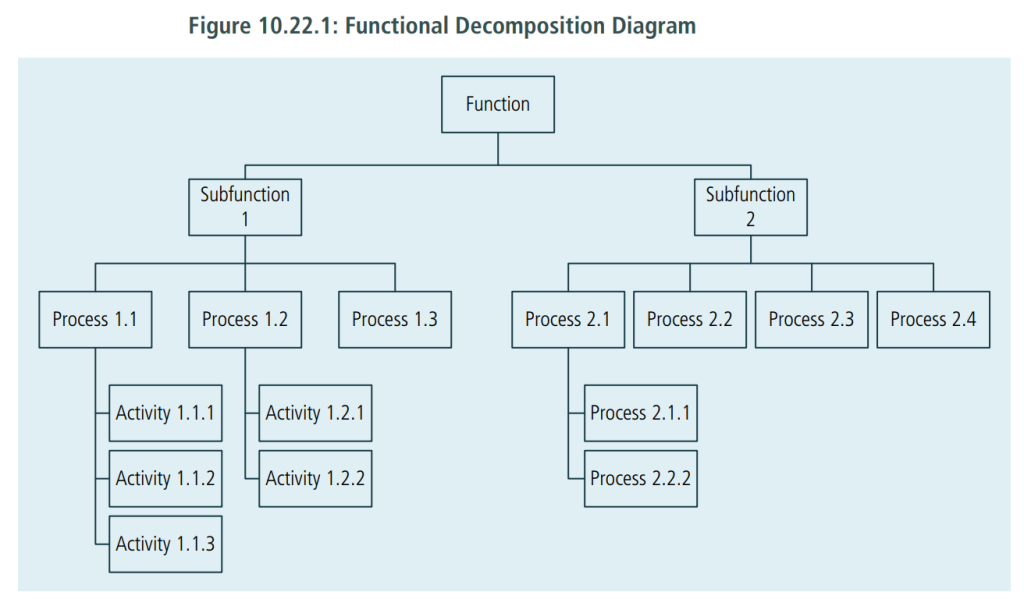10.22.1 Purpose
Functional decomposition helps manage complexity and reduce uncertainty by breaking down processes, systems, functional areas, or deliverables into their simpler constituent parts and allowing each part to be analyzed independently.
10.22.2 Description
Functional decomposition approaches the analysis of complex systems and concepts by considering them as a set of collaborating or related functions, effects, and components. This isolation helps reduce the complexity of the analysis. Breaking down larger components into sub-components allows scaling, tracking, and measuring work effort for each of them. It also facilitates evaluation of the success of each sub-component as it relates to other larger or smaller components.
The depth of decomposition may vary depending on the nature of components and objectives. Functional decomposition assumes that sub-components can and do completely describe their parent components. Any sub-component can have only one parent component when developing the functional hierarchy.
The diagram below provides an example of how a function can be broken down to manageable, measurable sub-components.

10.22.3 Elements
.1 Decomposition Objectives
Objectives of functional decomposition both drive the process of decomposition and define what to decompose, how to decompose, and how deeply to decompose.
The objectives may include:
- Measuring and Managing: to isolate specific manageable factors that contribute to the overall result, or to identify important metrics and indicators.
- Designing: to simplify a design problem by reducing and isolating the object of design.
- Analyzing: to study the essential properties and behaviors of an artifact or phenomenon in isolation from its encompassing environment.
- Estimating and Forecasting: to decrease the level of uncertainty by breaking down a complex value into its constituent factors.
- Reusing: to create a reusable solution building block that serves a specific function for various processes.
- Optimization: to detect or alleviate a bottleneck, reduce function cost, or improve process quality.
- Substitution: to make a specific implementation of a solution component or a function easily replaceable without impacting the system as a whole.
- Encapsulation: combining elements to make one element.
.2 Subjects of Decomposition
Functional decomposition applies to a wide variety of versatile subjects, such as:
- Business Outcomes: for example, income, profit, expenses, volume of service, or volume of production.
- Work to be Done: this decomposition (known as a Work Breakdown Structure or WBS) breaks endeavors into phases, milestones, work activities, tasks, work items, and deliverables.
- Business Process: to identify its constituent parts for the purposes of measuring, managing, optimizing, or reusing the process or its components.
- Function: to enable its optimization or implementation.
- Business Unit: to enable its reverse engineering and design.
- Solution Component: to enable its design, implementation, or change.
- Activity: to enable its implementation, modification, optimization, measurement, and estimation.
- Products and Services: to design, implement, and improve them.
- Decisions: for enabling, improving, or supporting them by identifying their inputs, underlying models, dependencies, and outcomes.
.3 Level of Decomposition
The appropriate level of functional decomposition defines where, why, and when to stop decomposing the subject in order to meet the analysis objectives. The process of functional decomposition continues until the business analyst has just enough understanding and detail to proceed and can apply the results of decomposition in the execution of other tasks.
.4 Representation of Decomposition Results
Representations of functional decomposition results allow business analysts to both validate and verify the results and to use them to solve other tasks. The results can be expressed as a combination of plain textual descriptions, hierarchical lists, descriptions using special formal notations (for example, mathematical formulas, Business Process Execution Language, or programming languages), and visual diagrams. A wide variety of diagramming techniques can be used to represent functional decomposition, including:
- Tree diagrams: represent hierarchical partitioning of work, activities, or deliverables.
- Nested diagrams: illustrate hierarchical part-to-whole relationships between decomposition results.
- Use Case diagrams: represent decomposition of a higher-level use case.
- Flow diagrams: depict results of a process or function decomposition.
- State Transition diagrams: explain the behavior of an object inside its composite state.
- Cause-Effect diagrams: elaborate on events, conditions, activities, and effects involved in producing a complex outcome or phenomenon.
- Decision Trees: detail the structure of a complex decision and its potential outcomes.
- Mind Maps: represent information in categories.
- Component diagram: depicts how components are wired together to form larger components and/or software systems.
- Decision Model and Notation: is used to analyze the business logic to ensure that it has inferential and business integrity.
10.22.4 Usage Considerations
.1 Strengths
- Makes complex endeavors possible by breaking down complex problems into feasible parts
- Provides a structured approach to building a shared understanding of complex matters among a diverse group of stakeholders.
- Simplifies measurement and estimation of the amount of work involved in pursuing a course of action, defining scope of work, and defining process metrics and indicators.
.2 Limitations
- Missing or incorrect information at the time decomposition is performed may later cause a need to revise the results of decomposition partially or entirely.
- Many systems cannot be fully represented by simple hierarchical relationships between components because the interactions between components cause emergent characteristics and behaviors.
- Every complex subject allows multiple alternative decompositions. Exploring all alternatives can be a challenging and time-consuming task, while sticking with a single alternative may disregard important opportunities and result in a suboptimal solution.
- Performing functional decomposition may involve deep knowledge of the subject and extensive collaboration with diverse stakeholders.
